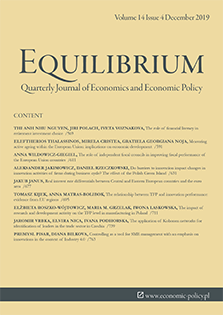Real interest rate differentials between Central and Eastern European countries and the euro area
Real interest rate differentials between Central and Eastern European countries and the euro area
Author(s): Jakub JanusSubject(s): Economic policy, International relations/trade, EU-Approach / EU-Accession / EU-Development, Financial Markets
Published by: Instytut Badań Gospodarczych
Keywords: real interest rates; Central and Eastern Europe; Economic and Monetary Union; financial integration;
Summary/Abstract: Research background: The question of changes in real interest rates differentials between the Euro Area and the CEE countries in the last years is raised because of two main reasons. The first rationale is related to the growing importance of external financial factors for the CEE economies and their monetary autonomy. The second reason is associated with the unprecedented shift in monetary conditions in the EMU, brought about by negative interest rates policy and unconventional policies, and the way it impacts the real rates in the CEE economies. Purpose of the article: This paper aims at exploring the relationship between real interest rates in the Euro Area and ten countries: Albania, Bulgaria, the Czech Republic, Hungary, North Macedonia, Moldova, Poland, Romania, Turkey, and Ukraine. The analysis covers the years of 1999- 2018, including periods before and after the financial and economic crisis. Methods: We employ Markov-switching regression to construct the ex-ante real interest rates series in each country, using monthly data on short-term interest rates and CPI inflation rates. A battery of unit root and stationarity test, both standard and panel ones, is applied to examine the real interest rate parity, also allowing for a structural break in the rate differentials. Findings & Value added: We provide detailed evidence on the real interest rates differentials for all of the CEE countries vis-à-vis the Euro Area. We find that, while panel stationarity tests point to the stability of real rate differentials, there are significant dissimilarities across the countries, and the results of the univariate tests are often mixed. At least half of the economies, however, reveal similar patterns of stationarity in real rates relationships. At the same time, we find differentials for the Czech Republic, Hungary, and Poland, countries highly integrated into the EMU economy, to be unstable over time.
Journal: Equilibrium. Quarterly Journal of Economics and Economic Policy
- Issue Year: 14/2019
- Issue No: 4
- Page Range: 677-693
- Page Count: 17
- Language: English

